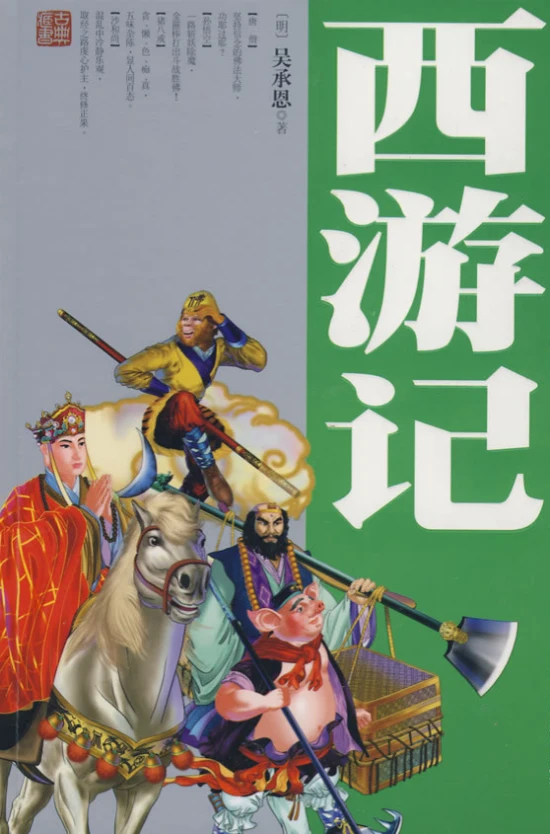Black Myth: Wukong Chapter 1 CG, background knowledge and detailed analysis
Hello everyone! So, we’ve been pretty tied up lately, and it looks like the PS5 is getting a real workout. For all friends who are big fans of Journey to the West, you’re in for a treat!
As I’ve been diving into the game, checking out the character designs, scenes, dialogues, and all those awesome stick technique names, I’ve gotta say, it just feels right. There’s something really satisfying about it. And every time I finish an animation sequence, it just hits me right in the feels.
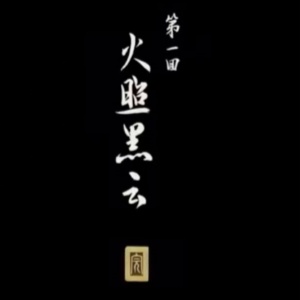
So today, I thought we could dive into the ending animation of Chapter 1, “Fire Shines on Black Clouds,” and see what cool stuff is packed in there. Sound good? Let’s jump in!
By the way, if you wanna check the video, Click here!![]()
Alright, picture this: It’s a quiet night in the mountains, and there’s this little monk, right? He’s sneaking around, holding a bowl of fish, and trying his luck at catching a golden toad. But, as you might guess, things don’t go as planned. That slippery toad gets away, bouncing off into the darkness.
Now, our determined little monk isn’t giving up that easily. He takes off after the toad, running through the trees, until suddenly, he stumbles upon something massive. Turns out, this golden toad’s got some serious backup. There’s a great king in the mountains, a huge creature that, to be honest, looks more like a bear than anything else. But here’s the twist—this big guy isn’t mean or fierce at all.
So, there’s the little monk, holding his bowl, and the great king sees him. Thinking the monk’s there to ask for alms, the king pulls out a bag of money and hands it over as a gift. But our little monk? Oh, he’s terrified. He drops to his knees, shaking like a leaf, begging for mercy.
But then something unexpected happens. Today, this bear-like king isn’t interested in causing harm—instead, he’s in the giving mood. The light from the coins shines on the monk’s face, and in that moment, when the monk looks up in pure surprise, that same light reaches down to the temple at the foot of the mountain—the Guanyin Temple.
Alright, so let’s break down what’s really going on here, because this paragraph is packed with layers.
First off, we’ve got this young monk carrying a burden. Now, at first glance, he doesn’t quite look like a monk from the temple down the mountain. Instead, he seems more like a traveler on a journey, someone who’s been on the road for a while.
Then there’s the question—why is a monk trying to catch a golden toad? Are we supposed to believe he’s planning to kill it and eat it? That doesn’t really fit with the image of a monk, right? But if we think about this in connection with Bro Bear giving money and the brightly lit Zen temple below the mountain, a different picture starts to form. The young monk might have traveled from far away, and catching that toad could symbolize something deeper.

Now, what’s the deal with asking for money if you’re planning to join the temple at the foot of the mountain? This actually ties into some historical context. You see, *Journey to the West* was published during the King Jiajing period of the Ming Dynasty. And during this time, there was an interesting policy that required anyone wanting to become a monk to pay a hefty sum to the state. The old system of “crossing butterflies” for monks was scrapped and replaced with the “jade butterfly” system. Essentially, it meant that if you wanted to become a monk, you had to pay up.
By the 18th year of the King Jiajing reign, there was a law called the “Sengdao Zhao,” which limited the number of monks allowed and required each monk to pay a sodium tax of ten taels of silver. So, in this context, the young monk could have been trying to gather money to join the temple, which might explain why he was on this journey in the first place.
So, here’s where it all ties together. Back in the day, there were too many monks and not enough temples, which led to frequent famines. This made becoming a monk a pretty desirable gig—steady food, shelter, and an escape from the hardships of everyday life. But, of course, if everyone was running off to become a monk, who’d be left to pay taxes and grow food? The country needed money for relief funds and military expenses, so the government started to see monks as a source of revenue.
That’s when they got the idea to “shear the sheep,” so to speak, and make even those who became monks without permission cough up some cash. By the 37th year of the King Jiajing reign, there was a new rule: monks and Taoists over the age of 16 who became monks without official permission had to pay a tax of six taels of silver.
Now, this brings us back to the young monk. He might have already taken his vows, but without a “Jade Butterfly”—which was the official document allowing him to join a temple like Guanyin Zen Temple—he still needed money. And where was he going to get it?
This is where the golden toad comes in. Remember how we talked about “The Plum in the Golden Vase” and Ximen Qing’s birthday gift sculpture, “Raising Sheep and Holding Longevity,” which included the legend of Liu Hai playing with a golden toad? That was also from the Ming Dynasty. The toad in folk culture often symbolized wealth, good fortune, and, interestingly enough, having many children.
So, in this story, the golden toad isn’t just a random creature—it represents something much deeper. It’s a symbol of wealth and the means for the young monk to secure his place in the temple. The act of catching the golden toad might be his way of gathering the necessary funds to pay his way into the monastic life.
So, here’s the thing about toads—they can lay up to 20,000 eggs at a time, which ties into this whole idea. When the legend of Liu Hai playing with the Golden Toad gained popularity, the meaning evolved. The toad wasn’t just a symbol of fertility anymore; it became associated with wealth too, especially since the Golden Toad was believed to have the magical power to spit out coins. This transformation in symbolism reflects the simple hopes and dreams of ancient people, making the young monk’s actions much clearer.
The young monk, in his quest to obtain the certificate (or “Jade Butterfly”), believed in this legend. So, he sneaked up the mountain in the dead of night, aiming to catch the Golden Toad. But then, Bro Bear (Brother Bear) showed up and flipped the situation on its head.
Now, Bro Bear wasn’t just any bear. He was like, “Hey, that toad’s my little bro. Don’t mess with him. You need a license? I’ve got cash—how much do you need?” But wait, was Bro Bear just a bank on legs? Of course not. If you zoom in and brighten the screen, the answer becomes pretty clear.
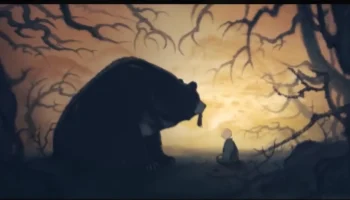
Bro Bear was probably a bandit in the past, robbing travelers, maybe selling roadside goods, even doing a bit of delivery on the side. But despite this, he didn’t harm the young monk. Not because he suddenly turned over a new leaf, but because he had his own reasons. He wanted to get close to the Guanyin Temple, be near it, soak in its spiritual vibes, and maybe even find his own path to enlightenment.
For Bro Bear, eating people was a way of life, but becoming a Buddha—that was his job now. So, he decided to stick around with those who were already on the monk path. But here’s the kicker—the money he offered came from someone he likely killed. The bones of the money’s original owner were probably lying around somewhere nearby.
The young monk, gazing at the Zen temple, realized this was the first time he’d let greed get the better of him. For his own desires, he took something that wasn’t his and ended up in league with a bear, with the Golden Toad as the catalyst. This whole scenario has that classic “Journey to the West” vibe, where nothing is as simple as it seems, and every action has a deeper meaning.
In the next scene, titled ‘I Love the Person Who is Destined to Be with Me,’ the young monk finally enters the Guanyin Zen Temple, just as he had hoped. As he steps inside, his eyes are filled with a mixture of awe and timidity. He moves cautiously, with a slightly bent posture, taking in the sight of this unfamiliar yet highly desirable world. The people around him seem similar to him in some ways, but there’s also a stark difference. While he wears simple, plain clothes made from rough fabric, the others are draped in luxurious robes.
Now, let’s take a moment to talk about the kasaya, which plays a significant role in this chapter. The word “kasaya” is a transliteration from ancient Indian language, referring to the traditional robes worn by monks. According to Buddhist records from the Tang Dynasty, monks were not allowed to wear robes in pure colors like green, yellow, red, white, or black. Instead, they wore garments in muted tones like bronze, earth, gray, and blue.
These simple colors served a dual purpose. First, they represented a rejection of worldly greed and attachment. The idea was to wear garments made from discarded, tattered fabrics, symbolizing the monks’ humble lifestyle. The robes were typically pieced together from various scraps of cloth, a reminder that everything they had—clothing, food—was obtained through begging and then carefully sewn together.
However, during the Tang Dynasty, this tradition began to change. For high-ranking monks, the royal family would occasionally “reward” them with more luxurious robes in colors like purple and crimson. This marked a significant departure from the earlier, more austere practices, reflecting the close ties between the Buddhist clergy and the royal court during this period.
Back in those days, it was crucial for the summoner to speak clearly when giving out commendations. A simple slip of the tongue could lead to some confusion—like an abbot mistakenly thinking he was supposed to hang the robe on the beam of his house instead of wearing it! (This wordplay is due to the similarity in pronunciation between the words “Ci zi” and “Ci si” in Chinese.)”Ci zi” -Grant a purple robe, “Ci si”- commit suicide by imperial order
Take Empress Wu Zetian, for example. She once rewarded a monk named Falang with a purple robe. Now, purple was a big deal in the Tang Dynasty—it was the color worn by officials ranked above the third tier, while crimson was reserved for those above the fifth tier. With such prestigious colors being handed out, the mindset among monks began to shift. Some monks yearned for these robes but couldn’t get them, while others, surprisingly, would refuse them when offered.
A famous instance of this happened during the reign of Emperor Xuanzong of the Tang Dynasty. A monk named Conghui requested a purple robe from the emperor, only to be publicly humiliated. The emperor bluntly told him, “It’s not that I’m stingy with the purple robe, but your level of cultivation is still too shallow—you might not be worthy of it.”
On the other hand, Emperor Xizong of the Tang Dynasty offered a purple robe to the eminent monk Yuanfang, but Yuanfang declined the honor without hesitation. Many respected monks believed that pursuing these luxurious robes, and the status they symbolized, was not the path to true spiritual enlightenment. But of course, not every monk shared that sentiment—especially not our Jinchi monk! He was probably among those who wouldn’t mind having such a distinguished robe.
So, our little monk has grown up, determined to study hard and elevate his spiritual practice like a true monk on the path to enlightenment. He’s trying his best to control himself, to rid his heart of the three poisons: greed, anger, and ignorance.
But no matter how much he tries to keep those desires in check, sometimes it’s just too much. Remember that “entrance fee” from the Black Bear Spirit? It seems like that gift was the key to unlocking the door of greed within him. And once that door creaked open, it wasn’t long before troubles started pouring in. The shadow of the bear, a symbol of his growing greed, started to linger over him, even as he rose through the ranks to become an abbot. The higher he climbed, the more frequently and clearly that shadow appeared behind him.
Finally, one day, he couldn’t hold it back anymore. In this pivotal moment, we see the abbot’s eyes, bloodshot and wild, as if he’s been possessed by the spirit of Bro Bear. Faced with the monks who were eagerly offering their robes, he snaps—waving his tin cane, sending the robes flying through the air.
He’s fighting with all his might to suppress his greed, but it’s a losing battle. Even the Guardian King Kong, standing by, is left stunned by the intensity of the struggle. The scene is a powerful portrayal of how even the most dedicated can be consumed by their inner demons when faced with overwhelming temptation.
Now, let’s dive into the deeper meaning behind the tin cane, which is much more than just a simple staff. In the world of Buddhism, the number of circular rings on a tin cane symbolizes the spiritual status and cultivation of its holder. For instance, Ksitigarbha Bodhisattva carries a staff with six rings, while both Kasyapa Buddha and Shakyamuni Buddha are depicted with staffs bearing twelve rings.
One of the most renowned artifacts that bring this symbolism to life is the silver flower double-wheel twelve-ring staff unearthed in 1987 from Famen Temple in Shaanxi Province, China. This staff, a national treasure, showcases how the number of rings signifies the level of spiritual attainment. For Elder Jinchi, possessing such a staff means he is nearing the ultimate goal—becoming a Buddha. However, the staff itself, with its rings, also represents restraint and self-control.
According to the “Dedao Ti Cheng Xi Zhu Jing” from the Southern and Northern Dynasties in China, the tin cane was originally used as a tool for monks to beg for alms without causing unnecessary disturbance. Instead of knocking on doors, which might startle or annoy the donor, the gentle jingling of the rings on the cane served as a polite and humble way to announce the monk’s presence.
The tradition was that the monk would shake the staff three times outside a household. If someone was willing to give, they would come forward. If not, the monk was expected to quietly leave without making a fuss, even if they were hungry. This practice was deeply rooted in the principles of restraint, humility, and respect for others’ generosity—or lack thereof.
In Elder Jinchi’s case, the tin cane isn’t just a symbol of his high status but also a reminder of the self-discipline required to maintain it. Yet, as we saw earlier, even with the cane in hand, the struggle to contain inner desires can be overwhelming, leading to moments where restraint falters.
In this reimagined version of the story, there’s a deeper exploration of Elder Jinchi’s character, adding layers of complexity to his journey. Here, we witness a transformation that goes beyond mere corruption—it’s about the struggle to overcome one’s darker impulses and return to the path of righteousness.
Elder Jinchi, who has already achieved a significant status within the Buddhist hierarchy, yearns to ascend even further. He genuinely desires to rid himself of his deep-seated greed and strives for self-restraint. When Tang Sanzang arrives, accompanied by Sun Wukong, we see Elder Jinchi as a humble monk, clad in a plain robe, hands clasped together in a gesture of humility and devotion.
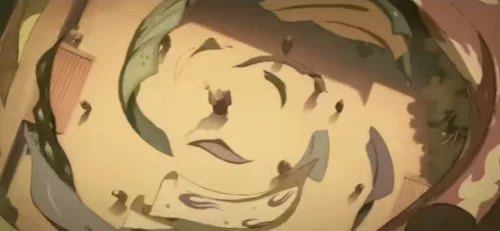
However, the sight of Tang Sanzang’s luxurious kasaya, adorned with gold-threaded dragons and cranes, completely shatters his resolve. This moment reveals a crucial truth: it wasn’t that Elder Jinchi possessed extraordinary self-control, but rather that he had never faced a temptation powerful enough to truly test him.
The progression from Master to Abbot, and finally to Immortal, signifies Elder Jinchi’s ambition. But in the face of absolute temptation, he becomes utterly consumed by his greed. The shadow of that first desire, symbolized by the bear, completely overtakes him, leading to his downfall. In the end, his unchecked greed manifests as a literal and figurative inferno, engulfing the Zen temple in flames.
And there, sitting on a tree in the distance, is Sun Wukong, observing it all with a knowing expression. The question lingers—does a monkey like Wukong carry a staff to deal with such situations? Of course, he does, and it seems Wukong is more than ready to step in, but perhaps only when the time is right.
In this final scene, the story takes on an even deeper, more symbolic meaning. The Wide-eyed Heavenly King’s fire shield protects Tang Sanzang’s quarters while the rest of the temple is engulfed in flames—a vivid representation of how unchecked desires can destroy everything in their path, even as some are shielded from the consequences.
As the temple burns, the player is treated to a beautifully detailed mural, capturing the chaotic and tragic scene. The artwork is so intricately crafted that you can zoom in to hear the frantic conversations of the characters. The first time through, it might seem like just another dramatic cutscene, but when you realize what you’ve missed, it’s too late to go back—you’d have to start the whole journey over again.
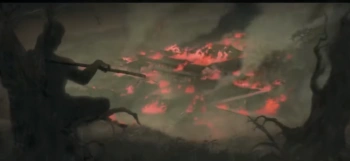
In this mural, the chaos of that night is brought to life: the traveler fanning the flames, the monks—who had sinisterly planned to burn Tang Sanzang—now caught in the blaze themselves, scrambling to save their possessions. Amidst all this, Tang Sanzang sleeps peacefully, protected by the fire shield borrowed from Wukong, oblivious to the destruction around him.
This scene underscores a powerful truth: while some bear the burden of protection and sacrifice, others, like the Black Bear Spirit, manage to slip through the cracks and find redemption. The Black Bear Spirit, who once succumbed to his desires, now serves as the Chief of Defense at Guanyin Bodhisattva’s temple in Nanhai. He wears the same gold hoop as Wukong, but the meaning has changed—where it once represented restraint for Wukong, it now signifies authority and responsibility for the Black Bear Spirit.
In a poignant moment, the Black Bear Spirit asks the Bodhisattva a question that lingers in the air: Why couldn’t Elder Jinchi, a monk who had supposedly shed all worldly attachments, let go of something as simple as a robe? The golden sea had dried up, and the monk’s dust had settled—so why was he still bound by desire?
This question remains unanswered, a reminder that the journey to enlightenment is fraught with challenges, and even the most devout can struggle to free themselves from the chains of desire. The story leaves us to ponder the complexity of human nature and the delicate balance between spiritual growth and the temptations that lie along the way.
“If I don’t put on this garment, how will sentient beings know that my dust connection has been cut off and my golden sea has dried up?”
This line draws from Chapter 55 of Journey to the West, where Tang Monk resists the temptation of the Scorpion Spirit by severing his worldly ties and awakening his Zen mind. It’s a powerful moment, capturing the essence of spiritual discipline and the struggle against desire.
Elder Jinchi’s 270-year journey can be seen as a long and arduous game between these two opposing forces—withdrawal from the world and immersion in it. The expectation is clear: a virtuous monk should have the “six pure roots” and eliminate the “six thieves,” which includes the tendency to see and desire, with a single strike. But in the secular world, we must acknowledge a hard truth: “Clothes make the man, and gold adorns the Buddha.” Respect often begins with the outward appearance before it extends to the person within.
This very scene underscores that point. The Black Bear Spirit, who was originally just another monster on Black Peak Mountain, becomes something more when he arrives at Mount Luojia in the South China Sea, the domain of Guanyin. What a place this is! When Monkey Brother first arrives, he is stunned by the beauty: towering peaks that pierce the sky, countless exotic flowers and auspicious grasses, trees swaying in the wind, and the sun reflecting off golden lotus blossoms. The Guanyin Hall, with its glazed tiles, and the Chaoyin Cave beneath its hat-like covering, the green poplar grove echoing with the songs of eagles, and the purple bamboo forest alive with peacocks—all of it speaks to the divine.
Living in such a paradise, a black bear adorned with a golden hoop is transformed. It’s no longer the rough creature from the mountains, but a refined guardian deity. Monsters cannot exist here—only protectors of the sacred.
So, as a high monk, is it the pursuit of inner purity that truly matters, or is it the external status, admired by millions? Perhaps, to achieve the latter, one must first attain the former, becoming a monk of great renown like Xuanzang. This question of whether the path to enlightenment lies in internal or external transformation is one that resonates throughout the journey. The Black Bear Spirit’s transformation suggests that perhaps the two are more intertwined than they first appear.
Your analysis delves deeply into the symbolic and philosophical layers of the narrative. The idea that the external appearance, such as a high-quality robe, can mimic inner purity raises a significant question: in a world where appearance can easily mask reality, how can one distinguish genuine enlightenment from mere imitation? This dilemma is particularly relevant in the context of Elder Jinchi’s journey. His struggle with greed and his ultimate downfall underscore the difficulty of maintaining true spiritual purity in a world full of temptations.
The comparison to the phrase from the Avatamsaka Sutra, “One flower, one world, one leaf, one Tathagata,” beautifully captures the idea that even the smallest aspects of life, like a falling leaf, can contain entire worlds within them. This suggests that the issues of monks, robes, and black bears are not just isolated incidents but are reflective of broader truths that pervade all of existence.
Indeed, the Black Myth seems to expose a darker truth—that everyone, in their quest for success or spiritual enlightenment, must face the same trials as Elder Jinchi. The Bodhisattva’s slight smile when answering the Black Bear Spirit hints at a deeper understanding, perhaps even a recognition of the inevitable struggles that come with spiritual advancement. It’s a reminder that the path to enlightenment is fraught with challenges, and even those who have spent centuries in study and contemplation, like Jinchi and Bro Bear, are not immune to the temptations and pitfalls that accompany their journey.
The Black Bear Spirit’s ability to navigate these challenges with a mix of fierceness, cowardice, and calculated confusion speaks to a kind of wisdom that transcends simple moral binaries. It reflects an understanding of the complexities of power, survival, and spiritual aspiration. This bear, who will likely be promoted upon his return, embodies the paradoxes of leadership and spiritual practice: the need to be both strong and adaptable, to know when to act and when to retreat.
In essence, this narrative reveals a nuanced view of enlightenment and leadership, suggesting that true wisdom lies not in rigid adherence to ideals but in the ability to navigate the complexities of life with both insight and humility. The story’s reflection on these themes offers a rich commentary on the human condition, where the line between genuine purity and superficial appearance is often blurred, and where success in any realm requires a delicate balance of strength, flexibility, and understanding.

